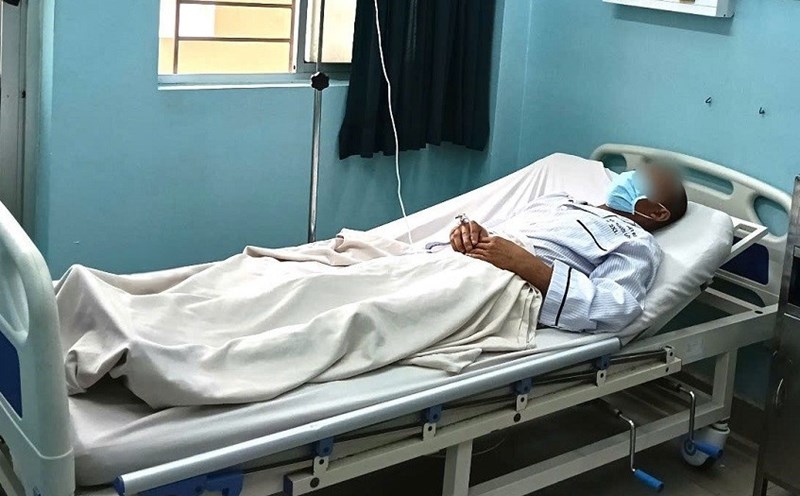1 case of globular encephalitis, 70 people need to be monitored
According to the Center for Disease Control (CDC) of Thai Binh, patient N.T.T (17 years old, residing in An Ap commune, Quynh Phu district) had symptoms of fever, sneezing, runny nose, muscle pain and sore throat. The family bought medicine for me to self-treat at home, during this time I still go to school normally.
On March 17, after returning from school, T showed signs of pain and fatigue, vomiting, and taking medicine that did not help him, so he was taken to Quynh Phu General Hospital for examination, then transferred to Thai Binh Provincial General Hospital.
Here, the patient was diagnosed with meningitis and septic shock. On March 18, the condition became worse, showing signs of neck stiffness, so he was transferred to Bach Mai Hospital for treatment.
PCR test results determined that the patient was positive for globular encephalitis and was diagnosed with globular encephalitis, complications of acute myocarditis and cerebral infarction. The patient is currently being treated for Rocephin and Glasgow at 15 points, his condition is stable and he is continuing to be monitored in the Intensive Care Unit, Institute of Tropical Medicine (Bach Mai Hospital).
Currently, more than 70 people in Thai Binh are being monitored for epidemics due to close contact with patients with scoliosis.
High risk of death in 24 hours
Associate Professor, Dr. Do Duy Cuong - Director of the Institute of Tropical Medicine (Bach Mai Hospital) said that scoliosis is a dangerous disease due to its rapid progress, which can take away a life within just 24 hours of the outbreak. The disease is transmitted through the respiratory tract and is at risk of leaving serious sequelae.
"Steroioioioioioioioioioioioioioioioioioioioioioioioioioioioioioioioioioioioioioioioioioioioioioioioioioioioioioioioioioioioioioioioioioioioioioioioioioioioioioioioioioioioioioioioioioioioioioioioioioioioioioioioioioioioioioioioioioioioioioioioioioioioioioioioioioioioioioioioioioioioioioioioioioioioioioioioioioioioioioioioioioioioioioioioioioioioioioioioioioioioioioioioioioioioioioioioioioioioioioioioioioioioioioioioioioioioioioioioioioioioioioioioioioioioioioioioioioioioioioioioioioioioioioioioioioioioioioioioioioioioioioioioioioioioioioioioioioioioioioioioioioioioioioioioioioioioioioioioioioioioioioioioioioioioioioioioioioioioioioioioioioioioioioioioioioioioioioioioioioioioioioioioioioioioioioioioioioioioioioioioioioioioioioioioioioioioioioioioioioioioioioioioioioioioioioioioioioioioioioioioioioioioioioioioioioioioioioioioioioioioioioioioioioioioioioioioioioioioioioioioioioioioioioioioioioioioioioioioioioioioioioioioioioioioioioioioioioioioioioioioioioioioioioioioioioioioioioioioioioioioioioioioioioioioioioioioioioioioioioioioioioioioioioioioioioioioioioioioioioioioioioioioioioioioioioioioioioioioioioioioioioioioioioioioioioioioioioioioioioioioioioioioioioioioioioioioioioioioioioioioioioioioioioioioioioioioioioioioioioioioioioioioioioioioioioioioioioioioioioioioioioioioioioioioioioioioioioioioioioioioioioioioioioioioioioioioioioioioioioioioioioioioioioioioioioioioioioioioioioioioioioioioioioioioioioioioioioioioioioioioioioioioioioioioioioioioioioioioioioioioioioioioioioioioioioioioioioioioioioioioioioioioioioioioioioioioioioioioioioioioioioioioioioioioioioioioioioioioioioioioioioioioioioioioioioioioioioioioioioioioioioioioioioioioioioioioioioioioioioioioioioioioioioioioioioioioioioioioioioioioioioioioioioioioioioioioioioioioioioioioioioioioioioioioioioioioioioioioioioioioioioioioioioioioioioioioioioioioioioioioioioioioioioioioioioioioioioioioioioioioioioioioioioioioioioioioioioioioioioioioioioioioioioioioioioioioioioioioioioioioioioioioioioioioioioioioioioioioioioioioioioioioioioioioioioioioioioioioioioioioioioioioioioioioioioioioioioioioioioioioioioioioioioioioioioioioioioioioioioioioioioioioioioioioioioioioioioioioioioioioioioioioioioioioioioioioioioioioioioioioioioioioioioioioioioioioioioioioioioioioioioioioioioioioioioioioioioioioioioioioioioioioioioioioioioioioioioioioioioioioioioioioioioioioioioioioioioioioioioioioioioioioioioioioioioioioioioioioioioioioioioioioioioioioioioioioioioioioioioioioioioioioioioioioioioioioioioioioioioioioioioioioioioioioioioioioioioioioioioioioioioioioioioioioioioioioioioioioioioioioioioioioioioioioioioioioioioioioioioioioioioioioioioioioioioioioioioioioioioioioioioioioioioioioioioioioioioioioioioioioioioioioioioioioioioioioioioioioioioioioioioioioioioioioioioioioioioioioioioioioioioioioioioioioioioioioioioioioioioioioioioioioioioioioioioioioioioioioioioioioioioioioioioioioioioioioioioioioioioioioioioioioioioioioioioioioioioioioioioioioioioioioioioioioioioioioioioioioioioioioioioioioioioioioioioioioioioioioioioioioioioioioioioioioioioioioioioioioioioioioioioioioioioioioioioioioioioioioioioioioioioioioioioioioioioioioioioioioioioioioioioioioioioioioioioioioioioioioioioioioioioioioioioioioioioioioioioioioioioioioioioioioioioioioioioioioioioioioioioioioioioioioioioioioioioioioioioioioioioioioioioioioioioioioioioioioioioioioioioioioioioioioioioioioioioioioioioioioioioioioioioioioioioioioioioioioioioioioioioioioioioioioioioioioioioioioioioioioioioioioioioioioioioioioioioioioioioioioioioioioioioioioioioioioioioioioioioioioioioioioioioioioioioioioioioioioioioioioioioioioioioioioioioioioioioioioioioioioioioioioioioioioioioioioioioioioioioioioioioioioioioioioioioioioioioioioioioioioioioioioioioioioioioioioioioioioioioioioioioioioioioioioioioioioioioioioioioioioioioioioioioioioioioioioioioioioioioioioioioioioioioioioioioioioioioioioioioioioioioioioioioioioioioioioioioioioioioioioioioioioioioioioioioioioioioioioioioioioioioioioioioioioioioioioioioioioioioioioioioioioioioioioioioioioioioioioioioioioioioioioioioioioioioioioioioioioioioioioioioioioioioioioioioioioioioioioioioioioioioioioioioioi The disease is transmitted through drip guns, often appearing in crowded areas such as kindergartens, groups, schools. The susceptible subjects are young people, those who are not immune or have not been vaccinated," Associate Professor, Dr. Do Duy Cuong added.
Meningococcal meningitis can cause many diseases:
don body: The progression is similar to other forms of meningitis, treatment takes about 2 weeks and can go away.
physical condition and beyond: The process progresses extremely quickly, in just a few days, with symptoms of sudden high fever, headache, nausea, impaired consciousness, coma, and necrotizing skin hemorrhage. In severe cases, the disease can cause acute adrenal insufficiency, shock and rapid death.
The mortality rate of the disease ranges from 10 - 20%. Cases of severe thrombosis infections or acute adrenal insufficiency are at risk of death within 24 hours if not treated promptly.
Associate Professor, Dr. Cuong said that meningitis is not common in the brain and spinal cord, mainly appearing in isolated outbreaks or introduced from other places. However, due to dangerous nature and rapid progress, the patient suspected of having a brain-ctome infection needed to go to a medical facility early for timely diagnosis and treatment.
More importantly, the disease can be prevented with vaccines. Therefore, people need to pay attention to getting fully vaccinated to protect themselves and the community, reduce the risk of disease and spread in society.











